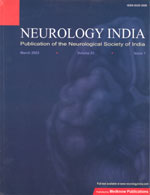
|
Neurology India
Medknow Publications on behalf of the Neurological Society of India
ISSN: 0028-3886
EISSN: 0028-3886
Vol. 58, No. 2, 2010, pp. 280-283
|
 Bioline Code: ni10070
Bioline Code: ni10070
Full paper language: English
Document type: Report
Document available free of charge
|
|
|
Neurology India, Vol. 58, No. 2, 2010, pp. 280-283
| en |
Endoscopic treatment of the suprasellar arachnoid cyst
Yadav, Y. R.; Parihar, Vijay; Sinha, Mallika & Jain, Nishin
Abstract
Surgical options for suprasellar arachnoid cyst are cystoperitoneal shunt, craniotomy fenestration and endoscopic fenestration. Endoscopic management has been found to be safe and effective. We report our experience with endoscopic management in 12 (male five, female seven; age range 8 months to 42 years) patients with suprasellar arachnoid cyst. The endoscopic procedure included lateral ventricle puncture by precoronal burr hole and superior and inferior wall of the cyst was communicated with the lateral ventricle and the interpeduncular cistern respectively. All patients had hydrocephalus. Four pediatric patients had macrocephaly. All adult patients had visual disturbances. One adult patient presented with psychomotor disturbance along with features of raised intracranial pressure. All cases improved following endoscopic treatment. There were no complications or death. One patient required VP shunt. Postoperative MRI showed significant reduction in cyst volume in 11 patients. Follow-up ranged from 6 months to 6 and a half years. Our study suggests that endoscopic technique is a safe and effective alternative treatment for suprasellar arachnoid cyst. It prevents complications such as subdural effusion and intracranial hematoma, which are not uncommon with craniotomy fenestration.
Keywords
Endoscopic treatment, intracranial cyst, minimally invasive technique, suprasellar arachnoid cyst
|
| |
© Copyright 2010 Neurology India.
Alternative site location: http://www.neurologyindia.com
|
|
